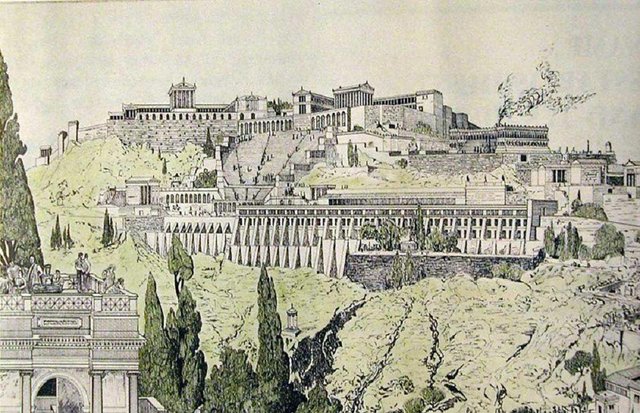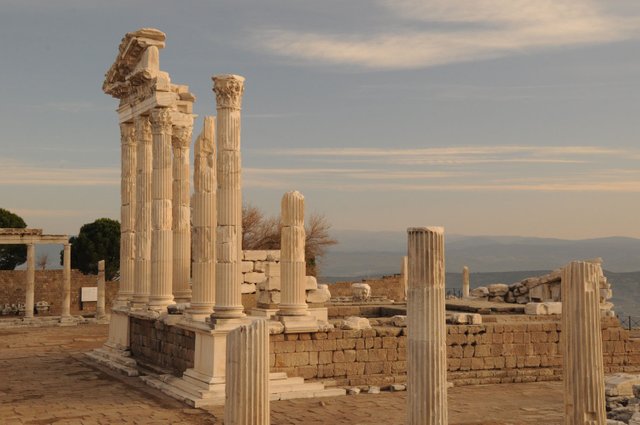The Library of Pergamon in todays Bergama, Republic of Turkey #3
There are two ways of interpreting the mixed, unmixed and simple roles: in analogy to the medieval codices miscellanei (collective manuscripts), those roles that contain several works by one or more authors mean mixed, while the unmixed ones contain only a single work or a part of a work. Simple means then only described on the front. Mixed stands for the total stock; After deduction of the double pieces you get the simple roles. A distinction between simple and unmixed is not made in these researchers. Wendel and Gober, who hold the second opinion, come to the conclusion that the less important double pieces have remained in Pergamon, since only the simple rolls were part of the gift. Otherwise, one must assume that only unilaterally described roles have been given away. The fact that the entire library was the subject of the donation seems doubtful, considering that Galen was literarily active in Pergamon in the second century AD, and that his contemporary Telephos may also be attributed to the Pergamene library staff (see above) and also was literary there.
Organization in the library
Using the example of the great library of Alexandria, Blum tries to reconstruct a library business, which finally led to the creation of the first actual bibliography, the pinakes of the scholar and poet Kallimachos. Blum distinguishes four stages
The bibliophylax (= bookkeeper) arranges the roles according to literature classes, authors and works, provides them with the title tag (Sillybos) and places them in the library cabinets. The works of an author are geornet after form and related content (exception: dramas and elegies alphabetically after the first letter of the title); Composite rolls presumably inserted under the title of the first work. On the cabinets panels (= pinakes in the strict sense) are attached, which list the contents of the cabinets.
inventory
Entering the roles in access directories, whereby the inventory reflects the arrangement of the roles in the cabinets. Composite roles are recorded only with the first included work; further works on the roll receive no proof. Cataloging (by Kallimachos): Creation of an overview of all works contained in the roles, organized by author class and author. Since the same works in the form of various copies (= copies) were present in the library, thus creating a copy of the inventory corresponding copy catalog. Each transcript is noted with a title, number of books and possibly the beginning (incipit) (in case of collective roles, the other author class and its first included work must be listed), for authors or titles in question, the work is attributed to the correct authors under the same authors, or the original title. Biographical notes and notes are incorporated into the transcription catalog. Creation of the catalog of works, the list of Greek writers and their writings (Pinakes), a kind of Greek national bibliography or biobliography, which was an excerpt from the transcript catalog and possibly also in the library non-existent, but known Kalimachos writings. The Pergamene pinakes, about which very little is known, were evidently designed according to the Alexandrian pattern. Remarks by Dionysius of Halicarnass lead to the conclusion that the authors were divided into classes and that biographical data preceded the lists of works. Perhaps it was created by the philosopher and grammarian Krates from Mallos (2nd century BC), as he is regarded as the most important of the Pergamene scholars. According to Wendel and Gober, the fact that the literary classes and the arrangement of the authors and their works corresponded exactly with the Pergamon and Alexandrian Pinakes is to be seen in the fact that ancient writers such as Plutarch were able to make comparisons as controversial authors (or minor titles) treat in both Pinakes have been. The preparation of a bibliography such as the Pergamum Pinakes, however, requires the same work steps as they have been outlined above on the basis of the Alexandrian Pinakes: Order of the acquired roles, possibly inventory, cataloging (transcript catalog) and creating the Pinakes (works catalog). A similar course of business must therefore be postulated in Pergamon.

